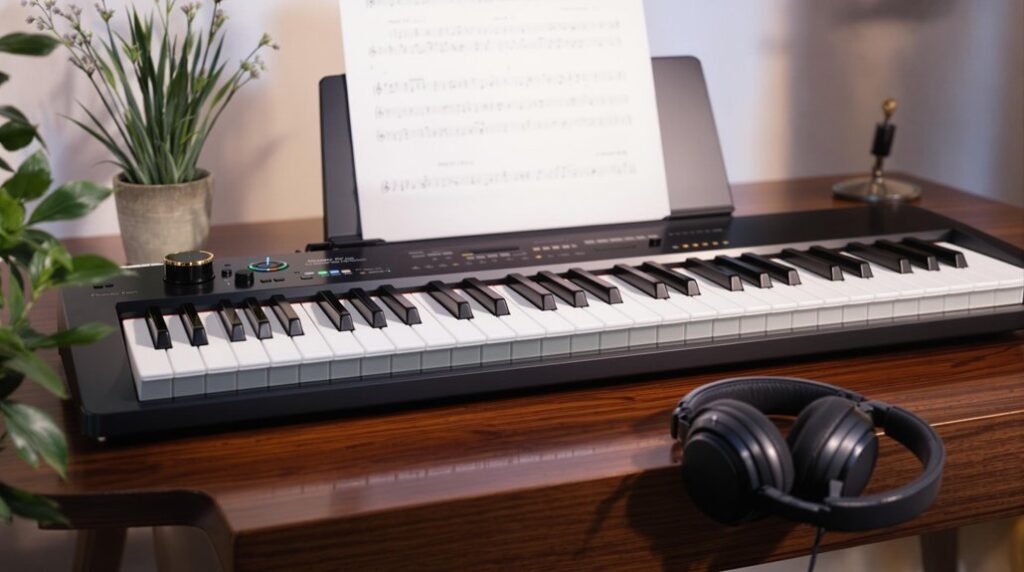Achieving excellence in audio mixing and music theory requires understanding seven essential components. Start with impeccable source quality, maintaining headroom to avoid distortion, and employ effective EQ techniques tailored to each instrument’s tonal balance. Organize your mix with precision, balancing effects, and utilizing compression to enhance rather than overwhelm dynamics. In music theory, utilize chord progressions and scales to craft emotionally resonant compositions. Focus on managing levels and dynamics to support genre-specific requirements while maintaining emotional depth. Mastering these fundamentals can boost your production skills considerably, revealing the intricate layers that contribute to a truly professional sound.
Key Takeaways
- Maintain headroom by keeping track levels between -10 dB and -12 dB to avoid clipping.
- Use EQ techniques like subtractive EQ to enhance tonal balance and clarity.
- Group tracks and use global effects sends for efficient mix organization and unique track sound.
- Avoid over-compression to preserve natural dynamics and prevent lifeless mixes.
- Understand and apply chord progressions and scales for emotional impact in compositions.
Source Quality Matters
Ensuring high source quality during recording is crucial to achieving a successful audio mix, as the foundation of any professional sound lies in the integrity of the initial capture.
The recording process demands meticulous attention to detail, where clarity is preserved by cleaning up low-frequency extremes and eliminating unwanted sections. Creating an acoustically dead zone around the microphone, using blankets or acoustic treatments, greatly reduces room coloration, preserving the purity of the source.
Employing a pop shield during vocal sessions prevents plosive sounds, essential for maintaining professional sound quality. Analyzing commercial mixes as a reference track offers insight into industry standards, guiding the establishment of optimal source quality in recordings. Moreover, ensuring attention to mastering techniques can further enhance the final product, contributing to its overall clarity and quality.
These practices are fundamental for producing polished, commercial-ready mixes.
Essential EQ Techniques
Mastering essential EQ techniques is vital for crafting a polished audio mix, as it allows engineers to sculpt the frequency balance of each element with precision and creativity. In the mixing process, EQ settings across individual tracks play a significant role in achieving tonal balance and dynamic range. For vocals, cut unwanted frequencies with a low cut below 100Hz, while enhancing presence at 2-4kHz. Electric guitars need clarity by cutting below 80Hz and boosting in the 800Hz-3kHz range. Bass guitars benefit from emphasizing 50-100Hz frequencies and defining character at 1-2kHz. Use EQ to remove boominess in acoustic guitars at 80-150Hz. Prioritize gain reduction and apply wide bandwidth boosts for ideal frequency spectrum refinement. Additionally, utilizing subtractive EQ techniques can significantly enhance clarity by cutting unwanted frequencies and reducing muddiness.
| Instrument | Frequency Cut/Boost | Purpose |
|---|---|---|
| Vocals | 100Hz, 2-4kHz | Clarity, enhance presence |
| Electric Guitars | 80Hz, 800Hz-3kHz | Clarity, fit in mix |
| Bass Guitars | 50-100Hz, 1-2kHz | Solid low-end presence |
| Acoustic Guitars | 80-150Hz, 4-8kHz | Balanced, clear sound |
| General EQ | Narrow cuts, wide boosts | Refine frequency spectrum |
Organizing Your Mix
While the artistry of mixing relies heavily on technical prowess and creative insight, the foundation of an effective mix is often rooted in organization.
Music producers benefit from creating a detailed track sheet or labeling audio tracks within the DAW’s arrange window, promoting efficient navigation. Grouping tracks into subgroups not only streamlines dynamics processing but also aids in achieving a cohesive mix balance by enabling simultaneous adjustments.
Initiating the mix in mono guarantees a robust balance of low frequencies before incorporating stereo imaging, which enhances spatial definition. Maintaining track levels around -10dB preserves headroom for the master bus, safeguarding against unwanted clipping.
Utilizing global effects sends fosters a unified sound, while still allowing individual audio tracks to retain their unique characteristics. Additionally, implementing gain staging ensures that levels are optimized throughout the mixing process, further enhancing audio clarity.
Effects and Separation
In the field of audio mixing, achieving effective separation and utilizing effects are critical components that can enhance a mix from ordinary to exceptional. Artificial reverb is indispensable in creating depth, with convolution reverbs favoring acoustic instruments and digital reverbs enriching vocals. Filtering low frequencies from reverb starting at 200Hz guarantees clarity and prevents muddiness, preserving separation between audio elements. Panning is pivotal for distributing backing vocals and doubled guitar parts across the stereo field, enhancing richness, while keeping lead vocals and bass centered maintains balance. Thoughtful consideration of pan positions and reverb types can craft an immersive audio experience without compromising mix integrity. Additionally, experimenting with decay time adjustments can further enhance the clarity and emotional impact of the mix.
| Element | Technique | Purpose |
|---|---|---|
| Reverb | Filter below 200Hz | Clarity |
| Backing Vocals | Spread across stereo field | Richness |
| Lead Vocals | Centered in the stereo field | Balance |
| Instruments | Distinct panning during recording | Separation |
Chord Progressions Tips
Crafting compelling chord progressions is a cornerstone of effective music composition, with common sequences like I-IV-V and vi-IV-I-V offering both historical significance and contemporary relevance.
By incorporating harmonic rhythm techniques, composers can manipulate the pace of chord changes to evoke excitement or create space for reflection, thereby shaping the emotional contour of a piece.
Additionally, exploring chord inversions can provide seamless shifts and enhance the overall textural depth of your arrangements. Understanding tension and release in harmonic progressions can further create listener satisfaction and emotional engagement.
Common Chord Progressions
Understanding common chord progressions is essential for anyone looking to master the art of music composition and production.
These progressions serve as key elements in crafting tracks that resonate emotionally through their sound. In music production, chord progressions guide mix elements, allowing for a seamless emotional impact by balancing major chords with their uplifting tones and minor chords with their melancholy depth.
- I-IV-V Progression: Widely used in pop and rock, this progression provides a strong sense of resolution and familiarity.
- ii-V-I Progression: A jazz staple, this sequence creates a smooth harmonic shift, enhancing the richness of the sound.
- vi-IV-I-V Progression: Known as the “Axis of Awesome,” its versatility shines across various genres, making it a go-to choice for many producers.
Harmonic Rhythm Techniques
When exploring harmonic rhythm techniques, attention to the rate at which chords change within a composition can dramatically influence its energy and emotional impact.
Utilizing common chord progressions, such as I-IV-V or ii-V-I, provides predictable frameworks that guide listeners’ expectations. However, integrating chord inversions and variations can add depth to changes, enhancing harmonic rhythm.
Syncopation within these progressions introduces tension and excitement, driving engagement through dynamic energy. Understanding music theory allows producers to craft cohesive arrangements by aligning harmonic rhythm with melodic movement, ensuring melodies and harmonies complement each other.
Levels and Dynamics
In the domain of audio mixing, maintaining consistent headroom is essential, with peaks ideally situated between -6dB and -3dB to provide ample space for mastering without risking distortion.
Dynamic range monitoring is equally critical, as it guarantees that musicality and impact are preserved, steering clear of the pitfalls of over-compression which can strip a track of its essence.
Employing metering tools not only aids in identifying and correcting problematic areas but also supports achieving genre-specific dynamic targets, guaranteeing that mixes resonate with intended emotional and sonic depth. Incorporating advanced compression techniques can significantly enhance the overall mix by ensuring that each element is balanced and impactful.
Maintain Headroom Consistently
To achieve a professional-sounding mix, maintaining consistent headroom is crucial, guaranteeing that the mix remains clear and free from distortion.
Effective mixing techniques involve setting track levels around -10 dB to maintain headroom while preserving dynamic range. To enhance clarity in the mix, metering tools are indispensable; they provide visual insights into levels and dynamics, helping you keep a balanced output.
Reference tracks are also essential in evaluating how your audio source compares, guiding adjustments for ideal headroom.
Consider these essential tips:
- Maintain Headroom: Keep levels between -10 dB and -12 dB to avoid clipping.
- Monitor Peaks: Target peaks should be between -6 dB and -3 dB.
- Use Reference Tracks: Regularly compare your mix to guarantee clarity and balance.
Dynamic Range Monitoring
Building on the foundation of consistent headroom, attention to dynamic range monitoring is a key aspect of crafting a professional mix that is both impactful and nuanced. Proper dynamic range management guarantees peak levels between -6dB and -3dB, preserving headroom and preventing distortion. Utilizing dynamic range meters provides visual feedback, allowing mix engineers to maintain mix clarity and avoid over-compression, which can result in a lifeless sound. Regularly comparing against genre-specific reference tracks aids in identifying discrepancies and guiding necessary adjustments. This practice enhances the professional sound of the mix.
| Aspect | Purpose | Result |
|---|---|---|
| Peak Levels | Maintain headroom | Prevent distortion |
| Visual Feedback | Monitor loudness consistency | Enhance clarity |
| Reference Tracks | Identify discrepancies | Guide adjustments |
Consider genre-specific targets for ideal punch and presence.
Avoid Over-Compression
Although compression is an essential tool in audio mixing, its misuse can strip a track of its liveliness by excessively reducing its dynamic range.
To mix perfectly, it’s vital to monitor dynamic range and maintain peak levels between -6dB and -3dB, providing ample headroom for mastering.
Dynamic processors should enhance, not squash, a track’s natural dynamics, ensuring an engaging and polished final product.
Common pitfalls include over-compression for loudness, which can lead to a lifeless mix.
Instead, consider the following steps:
- Use metering tools to identify over-compression and retain natural dynamics.
- Adjust attack and release settings to preserve transient responses and avoid a flat sound.
- Focus on proper leveling to achieve clarity and energy without unnecessary compression.
Scales and Modes
Scales and modes form the foundation of musical composition, providing the framework through which musicians express a wide array of emotions and styles. Scales, defined as sequences of notes, are pivotal in shaping musical textures and emotional depth. Major scales typically evoke happiness, while minor scales often convey somber emotions. Modes, such as Mixolydian and Phrygian, are variations that start on different root notes, further diversifying the sound palette. Understanding the specific intervals within these scales and modes enhances creative expression, allowing for nuanced emotional storytelling. Additionally, exploring musical scales reveals how different emotional qualities can be conveyed through varying note sequences.
| Mode | Characteristics |
|---|---|
| Ionian | Bright, happy (Major scale) |
| Aeolian | Melancholic (Natural minor) |
| Mixolydian | Bluesy, common in rock |
| Phrygian | Exotic, Spanish-like quality |
These elements are essential for crafting diverse musical styles.
Frequently Asked Questions
What Role Does Tempo Play in Audio Mixing?
Tempo plays an essential role in audio mixing by influencing the overall feel and pacing of a track. Tempo importance lies in its effects on synchronization and consistency, requiring adjustments and mapping to accommodate perception and variations effectively.
How Does Understanding Rhythm Improve Mixing Outcomes?
Understanding rhythm enhances mixing by optimizing rhythm patterns for groove creation, utilizing syncopation effects and precise beat placement. Effective drum layering, timing precision, dynamic shifts, and pulse recognition collectively enhance the feel and depth of audio productions.
Why Is Song Structure Important in the Mixing Process?
Song structure is essential in mixing as it influences song dynamics, arrangement flow, and listener engagement. Understanding structural variation guarantees mixing clarity, aligns with genre conventions, enhances emotional impact, supports production consistency, and facilitates creative shifts.
How Can Music Theory Influence Vocal Arrangement Decisions?
Music theory profoundly influences vocal arrangement through scale selection and interval choices, enhancing vocal harmonies. It dictates melodic contour, aligns with chord progressions, and utilizes dynamics variation, phrase structure, and tension release to emphasize lyrics effectively.
What Are the Benefits of Using Different Time Signatures in Mixing?
Utilizing different time signatures in mixing fosters polyrhythmic textures, enhancing syncopated beats and dynamic contrast. This creative experimentation enables rhythmic cohesion and creative shifts, facilitating genre exploration while amplifying emotional impact and listener engagement through innovative and expressive audio environments.
Conclusion
In the domain of audio mixing and music theory, a thorough understanding of key elements is indispensable. High-quality audio sources lay the foundation for successful projects. Mastery of EQ techniques and effective mix organization guarantees clarity and cohesion. Utilizing effects strategically enhances separation and sonic depth. Proficiency in chord progressions, attention to levels and dynamics, and a solid grasp of scales and modes are vital for crafting compelling musical compositions. These components collectively raise the artistry and technical precision of audio production.




